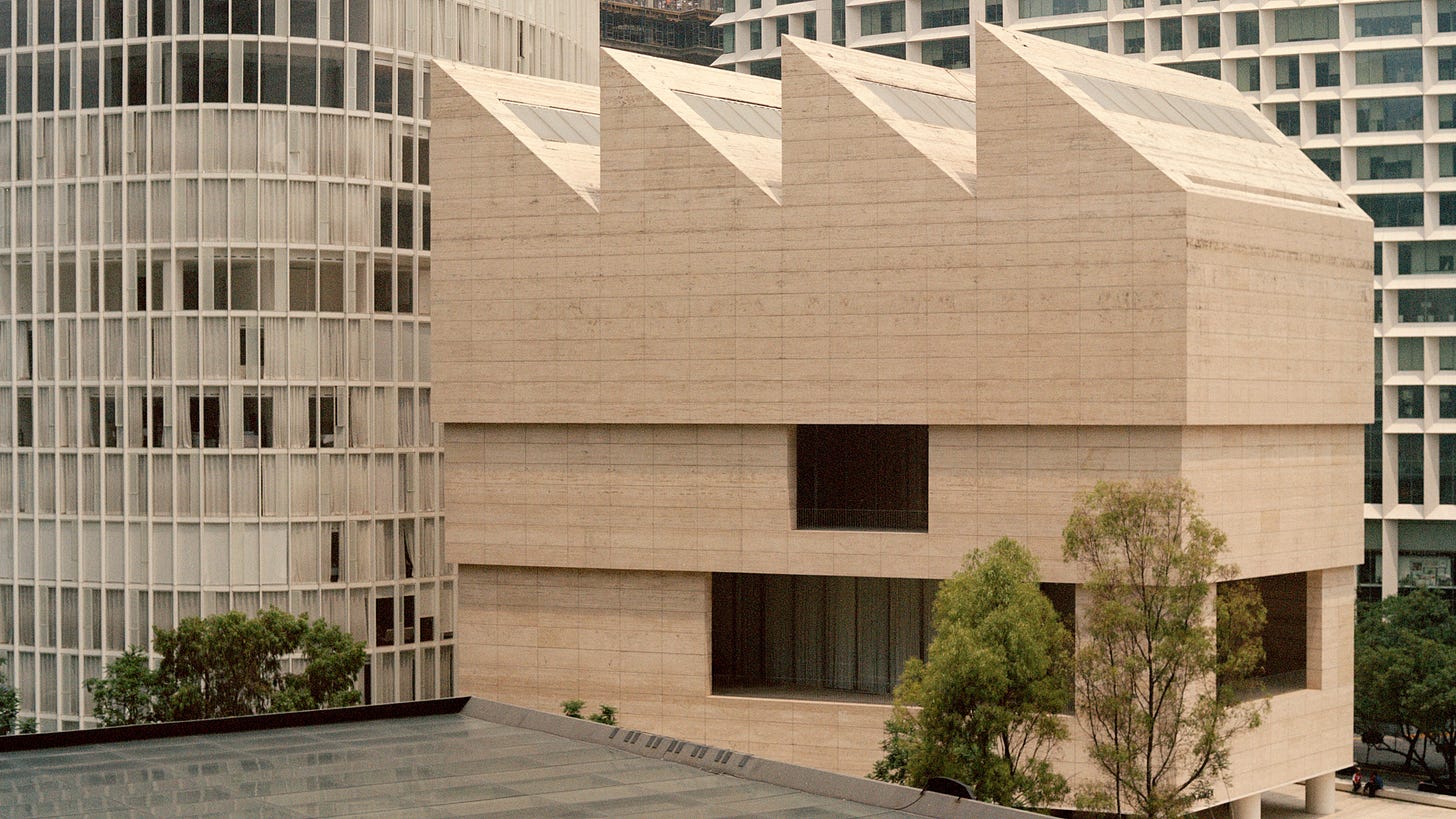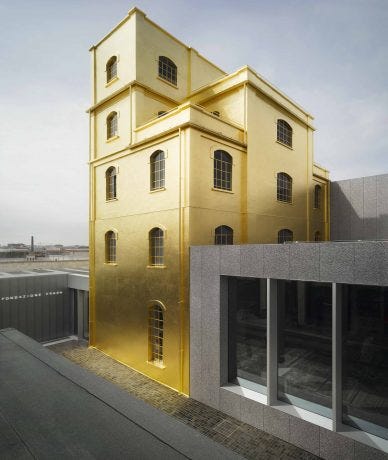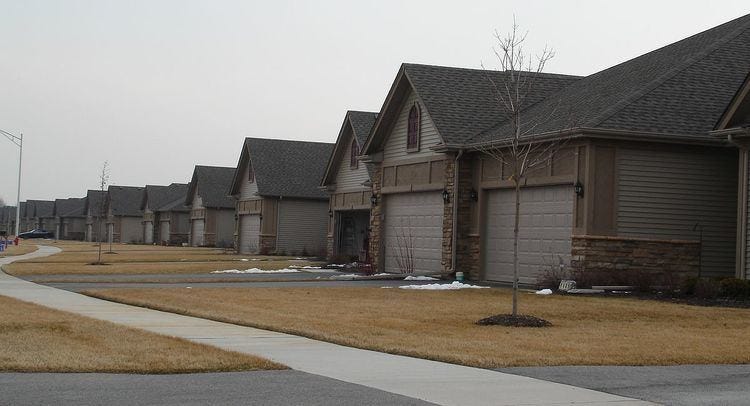Ugly Architecture, Mediocre Buildings
The question of why new buildings are all so terrible is in the air. Tyler Cowen wrote a column on why pre-WWII residential neighborhoods seem so much nicer than post-war neighborhoods. Scott Alexander is indulging wild conspiracy theories about an ancient civilization (not really). A different Scott has offered some helpful responses to both Cowen and Alexander.
The question obsesses me. I went to Architecture school to try to figure it out. I haven’t — look around you! — but I can offer a clarification, which is that the problem is divided into two related but conceptually distinct puzzles:
The Unpopular Architecture Puzzle: many people don’t like modern institutional buildings. They find them freakish, or boxy, or just ugly. These buildings are capital-A Architecture, and they’re divisive. This is puzzling because it seems like a relatively recent phenomenon. We don’t have any records of people hating on the Pantheon or the Great Mosque of Djenné when they were built. There was a time within the last century, even, when most people seem to have just straightforwardly liked big new buildings, like the Lincoln Memorial (1922) or the Chrysler Building (1930). What changed?
The Mediocre Building Puzzle: many people don’t like recently built neighborhoods, apartment buildings, or office buildings. As Tyler Cowen points out, older residential neighborhoods command price premiums relative to newly built neighborhoods, and if you browse New York real estate listings you’ll quickly find that brokers love advertising that buildings are “pre-war.” This seems odd given that pretty much every place on Earth is much richer than it was before WWII, and modern OECD countries are the richest places in all of human history. If their citizens prefer the old neighborhoods/buildings to the new neighborhoods/buildings, why doesn’t the market just provide more of what they want?
These two problems are often conflated (Scott A, for instance, seems to jump back and forth between them), perhaps because they’re both part of a vague but very widespread feeling— it seems to be almost universal in the US, at least — that everything about our built environment just kind of sucks nowadays.
But they’re very different, conceptually, and many proposed explanations for the vague-sense-of-general-badness relate only to one or the other of these puzzles. I’ll show this by using two of the most commonly cited explanations as examples: 1. elite signaling, and 2. the rising relative cost of labor (aka Baumol’s Cost Disease).
So, suppose that your thesis is that buildings are terrible now because of elite signaling within the establishment. When elite institutions want to build a new building, the thinking goes, they want it to be an elite-institution kind of building. To get one of these elite-institution buildings you have to hire a capital-A Architect to design some capital-A Architecture for you.
There’s a lot to like about this hypothesis. The list of capital-A Architects in the world is in fact informally controlled by a fairly small group of people who are all architects and members of the social elite themselves — it’s not a conspiracy, this is just how artistic professions tend to work. And there really are esoteric aesthetic trends within this small group, which take years of immersion to understand and appreciate, like a foreign language. If you fail to hire a capital-A Architect and instead hire some random architect to design you a non-capital-A kind of building, your building will not follow or even relate to these trends, which will make your building look ridiculous to your fellow elites. And so, to a certain extent, a small group has the ability to impose their preferred aesthetics, which are hyper-sophisticated and often unpopular, on institutions who want capital-A Architecture, purely because of in-group signaling.
But this explanation has no direct connection to the Mediocre Buildings puzzle. The developers who build McMansions and those dreadful 5-over-1 apartment buildings do not care — at all, I promise — about the opinions of the capital-A Architecture people. They build them because that’s what their customers want, in aggregate, as determined by the market. The architects who design new office buildings might care a little — they’re a small step above the McMansion designers in the world’s architectural pecking order — but ultimately they are guided by their clients’ tastes and budgets. And the intersection of those tastes and budgets is your standard glass-box office building. Capital-A Architects hate McMansions, and they probably think your local office building is ugly, too. (They might praise some other office building that, to you, looks exactly the same as your ugly local building, but they will at least agree with you that the local generic glass box is bad and not good.) So, if elites hates McMansions, and hate local generic glass boxes, and non-elite, salt-of-the-earth you also hate them, why are they still being built? The elite signaling hypothesis fails on this point.
Maybe at this point you pick another likely hypothesis: the rising relative cost of labor. It is well understood that as societies get richer, the cost of labor relative to other inputs increases. On this view, what is perceived as “nicely ornamented” vs “generic and boring” might be just a proxy for how many hours of skilled labor went into a building. Anyone in a position to build a whole building 100 years ago could afford a small army of skilled craftsmen to make little carvings, or to reshape a piece of wood until it fit just so, but nowadays builders try to use as little labor as possible, because labor is so much more expensive than the physical stuff a building is made out of.
This does explain McMansions, maybe. People who live in McMansions would prefer houses that looked more like pre-war mansions, presumably, but it turns out to build a pre-war mansion you have to hire a bunch of skilled craftspeople. You can own a mansion-sized house as a normal upper middle class person in America, but you can’t afford all the hand-crafted details and ornament that make old mansions look so nice. Thus, McMansions.
But this does not explain capital-A Architecture. Note for instance, uh, this:
Yes, that is an entire building plated in real gold.
Or, consider this building, designed by the same firm:
Maybe you like the gridded blob and maybe you don’t, but in either case this is exactly the kind of building people have in mind when they complain about “Modern Architecture.” It doesn’t resemble traditional, pre-war public buildings. It has a shape that seems totally arbitrary. It’s made of glass and steel. It’s not colorful.
Both the gold-plated thing and the gridded blob were extremely expensive to build. It’s not that the institutions that commissioned these buildings wanted a traditional, richly ornamented building but were just priced out and had to settle for covering their entire building in gold / constructing a giant alien blob instead. These institutions paid top dollar for what they wanted, and what they got: Architecture, designed by an Architect.
So, is it just that each of these problems is completely distinct, and has a different explanation? Maybe rising labor costs leads to McMansions, and elite signaling leads to fancy blobs?
I think that’s basically correct, yes. But there’s less to these explanations than there might seem.
Let’s take them one at a time:
Why are rising labor costs expressed as less detail/ornamentation? Some kinds of activities — performing a string quartet is the canonical example — just intrinsically require a certain amount of labor. No amount of economic growth will alter the fact that it takes four musicians about 15 minutes each to play Beethoven’s Grosse Fuge. But why does it necessarily take longer to make nicely detailed and ornamented buildings than it does to make McMansions? The free market is very, very good at giving consumers the manufactured goods they want, and it gets better at it every year, whether it’s televisions, sneakers, or cars. Why can’t the market mass produce ornaments and details that are cheaper and better than what craftspeople used to produce by hand?
The answer to this question is extremely not obvious. There is, after all, a huge market incentive for solving this problem. And yet not only is it not solved, the market has not, so far, been able even to provide buildings that are cheaper than they were fifty years ago, holding quality constant (quality isn’t constant, of course, but it also isn’t clearly better; while houses are certainly much better insulated and safer in fires than they used to be, they’re also a lot less robust to water leaks, offer poorer air quality, and are certainly less ornamented!). Well capitalized, intelligent people have been trying to mass produce houses since Henry Ford was alive, since mass production is a well understood way of improving quality and reducing production costs, and yet the vast majority of buildings in the world are still built as one-offs. To get a sense of just how many credible attempts there have been to solve this problem, it’s worth browsing through Brian Potter’s Construction Physics Substack. All the obvious moves have been tried.
The elite signaling hypothesis fares even worse as an explanation. While it undoubtedly describes some part of the cultural mechanics by which gridded blobs are produced, it explains nothing. Did the world of a century ago not have elites? Did those elites not play signaling games? If so, why is it only in recent years that these signaling games have produced buildings that, instead of universally impressing the public, impress some and alienate many more? Any explanation that explains what changed is in the business of explaining Modernism as a whole. This sounds much harder than chalking things up to signaling, which is to say that the signaling explanation does not add much in solving the real puzzle.
If you’ve read this far, I’m sorry to say I haven’t figured out the answer to either of these puzzles. But I believe progress can be made on both fronts. Perhaps another century hence we’ll look back on the present time as an odd aberration in the history of buildings. Maybe one of Abodu, Cover, Boxabl, or some other as-yet obscure startup will have figured out how to provide quality detailing, and maybe even ornamentation, at scale. Maybe the small neo-classical insurgency among professional architects will have triumphed, and glassy blobs will give way once again to marble colonnades. Or perhaps some grand new architectural synthesis will emerge that recaptures the charisma of old buildings without just recapitulating their forms. I just hope they’re not still building McMansions in 2121.






Is there something intrinsic about 5-over-1 design that makes them dreadful, or is it just that 5-over-1 is a cost-savings style and building that are optimized to reduce cost tend to not spend money on looking good?